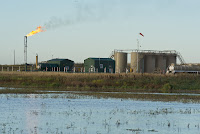Regulating carbon dioxide, by far the most common greenhouse gas, is critical to halt the emissions that cause climate change. But methane is a very close second, and for the first time, the federal government is moving to significantly rein in methane pollution.
The Obama administration released a proposed rule Tuesday to regulate methane emissions from new and modified oil and gas wells across the country. How much? It’s complicated.
In January, the administration announced the goal of cutting methane emissions from the oil and gas sector between 40 and 45 percent from 2012 levels by 2025. This proposal would help get the United States to that goal, but would not do it on its own.
Tuesday’s proposed action focuses on new hydraulically fracked oil and gas wells. It would “require methane and VOC [volatile organic compound] reductions from hydraulically fractured oil wells, some of which can contain a large amount of gas along with oil, and would complement the agency’s 2012 standards addressing emissions from this industry,” according to an EPA fact sheet. Specifically, it updates the 2012 New Source Performance Standards to set these methane and VOC guidelines for new and modified wells.
...
Tuesday’s proposal could represent 20 to 30 percent of the total national methane emissions reductions, and a significant amount of the 40 to 45 percent target, according to McCabe.
It would also extend the requirements farther downstream from the oil and gas extraction sites, meaning that leaks along the transmission infrastructure would be reduced. Operators would be required to find and repair leaks under the proposal.
The action would also supply draft guidelines for cutting VOC emissions in ozone nonattainment areas, mostly places in the Northeast with higher-than-allowed ozone levels. VOCs are mixed in the ground with methane and when they are emitted, they help create ground-level ozone, or smog. Apart from the ozone nonattainment areas in the Northeast, the proposal largely does not apply to existing or abandoned wells, though if transmission lines are repaired to prevent leaks, existing wells could see some emissions reductions.
Read more at How the EPA Plans to Cut Methane Emissions from Oil and Gas Wells

No comments:
Post a Comment